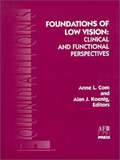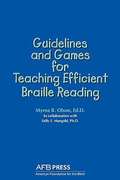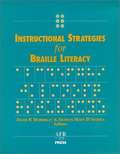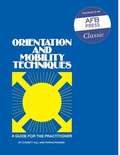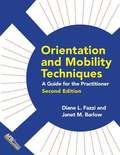Special Collections
American Foundation for the Blind
Description: American Foundation for the BlindPress offers a wide range of information for students, professionals, researchers, and blind and visually impaired people and their families. #teachers #disability
- Table View
- List View
Foundations of Low Vision
by Alan J. Koenig and Anne L. CornThis text explains in great detail how to do low vision exams, the principles behind magnifiers and other forms of magnification, and much more.
From Homer to Helen Keller
by Richard Slayton FrenchFrom Homer to Helen Keller, Homer stands for the greatest achievement of the blind in the times antecedent to their systematic education. He stands for all those bards, many of them blind or blinded, creators of literature and makers of our language, who through ballads, always of great vigor and sometimes of surpassing beauty, have handed down to us the glorious traditions of far-off heroic times.
Miss Keller stands for the supreme achievement of education. The blind claim her, but the deaf can claim her, too, and modern education can claim her more than either--and all humanity claims her with the best claim of all. For she is the epitome of all that is best in humanity, all that is most spiritual; and all this through conscious aim and directed effort, through education in its best sense.
The Future of Work for Disabled People
by Ian Morris and Wassily Leontief and Walter Y. Oi and William F. Gallagher and Curt Tausky and Timm Kainen and Lawrence A. Scadden and William J. Dennis and Dennis Chamot and Jesse M. Smith and Erich Bloch and Joseph F. CoatesThis important book, by an impressive and talented team of authors, will help us plan to ensure that workers with disabilities find their rightful place in the workplace of the future.
Guidelines and Games for Teaching Efficient Braille Reading
by Myrna R. Olson and Sally S. MangoldThese unique guidelines and games provide ideas for adapting a general reading program to the needs of braille readers and enriching early instruction in braille that are based on research in the areas of rapid reading and precision teaching. Classroom teachers and anyone working with children who are blind or visually impaired will find this classic handbook an invaluable resource.
Hand in Hand
by Elga Joffee and Jeanne Glidden Prickett and Therese Rafalowski Welch and Kathleen Mary HuebnerThis series was designed to develop resources for educators of children who are visually impaired, hearing impaired, and severely disabled. The Hand In Hand materials emphasize the communication and mobility skills crucial to independence, and provide important information to help service providers do their jobs effectively. Containing contributions from more than 30 nationally recognized experts in the field of deaf-blindness, this groundbreaking information consists of four components that can be used separately or together. A two-volume, self-study text that explains how deaf-blind students learn, focusing on essential communication and mobility skills. Designed to provide comprehensive information in an easy-to-read way, this invaluable resource includes identified key concepts, self-study questions and answers, and references. The user-friendly format includes concise "Help at a Glance" and "From Theory to Practice" sections throughout. Sidebars, figures, tables, graphs, and photos offer additional perspectives and information.
HIV/AIDS Prevention
by Judy Matsuoka and Christine E. Pawelski. and Gaylen KappermanThis manual is designed to help rehabilitation teachers, educators, and other practitioners who work with blind and visually impaired persons provide their clients with the facts they need to deal with the issues concerning HIV/AIDS.
Images of Blind and Visually Impaired People in the Movies, 1913-1985
by Wendy Erickson and Diane WolfeListed in this book are the titles and other information about movies that include characters who are blind or visually impaired.
The Influence of Parental Attitudes and Social Environment on the Personality Development of the Adolescent Blind
by Vita Stein SommersThe author's experience with visually handicapped children and young adults in schools is richly used in this study of the influence Of parental attitudes and social environment on the personality development of the adolescent blind.
Instructional Strategies for Braille Literacy
by Diane P. Wormsley and Frances M. D'AndreaOffers instructors specific, practical strategies for the teaching of Braille reading and writing. Chapters discuss general guidelines and strategies; fostering emergent learning; making the transition from print to Brail teaching Braille to students with special needs, and to students who speak English as a second langua assessing the literary skills of students who are blind or visually impaired; and technology and Braille. Annotation copyrighted by Book News, Inc. , Portland, OR
An Introduction to Working with the Aging Person Who Is Visually Handicapped (2nd edition)
by Dava GraysonThis book deals with aged blind persons, the ways and means of lending them a helping hand, services available to them, and solving other problems.
Living with Impaired Vision
by Anne Yeadon and Dava GraysonBlind and visually impaired people: active, concerned about their jobs, their families, their communities, obtaining a good education, discovering interesting ways to use their leisure time, and above all, as different from one another as any other group of people who happen to have one characteristic in common. Today there are visually impaired people in every major area of employment from professional occupations to technical and clerical work. There are blind lawyers and college professors and insurance salesmen and social workers, blind typists and switchboard operators, auto mechanics and chemical engineers.
Looking at Employment Through a Lifespan Telescope
by Corinne Kirchner and Emilie Schmeidler and Alexander TodorovThis book gathers representative survey data from the legally blind population on employment issues, and analyzes it using a lifespan perspective (considering age, career stage, and age-at-onset of visual impairment), which is critical to understanding widely different employment issues for subgroups of the blind and visually impaired population.
Low Vision
by Virginia E. Bishop and Jane N. Erin and Anne CornThis research report, based on a multiphase survey of professionals, identifies important trends into the next century. Designed for administrators, policy planners and university instructors, as well as for direct service providers, Low Vision includes background overview papers by six eminent leaders in the low vision field.
Mainstreaming and the American Dream
by Howard Nixon IIBased on in-depth interviews with parents and professionals, this research monograph presents a sociological framework for looking at the needs and aspirations of parents of blind and visually impaired children.
Manual for the Stanford Multi Modality Imagery Test
by William L. DautermanThe author's data on the test called "The Stanford Multi-Modality Imagery Test for the Blind" as a part of a research project has been revised in this manual under the name of "The Stanford Multi-Modality Imagery Test."
Non-Sighted and Sighted Adults' Volumetric Perceptions of Functional Objects
by T. M. Nelson and C. J. Ladan and J. EppsA report on the study of the manner in which sighted, sighted-but-blindfolded, late-blind (subsequent to 7 years of age), and congenitally blind (blind since birth) persons employ physical parameters in determining weight and volume of functional objects.
No Time to Lose
by Pauline M. MoorMultiply impaired blind children present special educational problems and as their number increases, their educational needs are of increasing concern, because many of them arrive at school severely retarded in their development. Several years ago the American Foundation for the Blind called a seminar to discuss teaching procedures then being used, as well as ideas for new techniques. The participants came from the field of special education; most were classroom teachers who had extensive experience with multiply impaired blind children. This report is an outgrowth of that meeting.
Orientation and Mobility Techniques
by Everett W. Hill and Purvis PonderA large-format manual covering definitions, techniques, and devices, designed for administrators, educators, rehabilitation counselors, and other professionals concerned with the mobility training process. A classic compilation of information on an essential subject.
Orientation and Mobility Techniques
by Diane L. Fazzi and Janet M. BarlowThe very first techniques book in orientation and mobility has been completely revised and updated for today's fast-changing world, while remaining true to Hill and Ponder's simple organizational principles that generations have known and loved. A new, easy-to-read color format, accompanying photographs, updated information on street crossings at complex intersections, and a new chapter on O&M for people with low vision make this revised edition a must-have in your O&M library.
Perceptual Factors in Braille Word Recognition
by Carson Y. Nolan and Cleves J. KederisThis monograph presents the findings of several years of study of the braille system as a communication process.
Piagetian Reasoning and the Blind
by Yvette HatwellThe book reports the results of a series of studies undertaken in the early 1960s on the cognitive development of children with congenital blindness.
Prescriptions for Independence
by Nora Griffin-Shirley and Gerda GroffPrescriptions for Independence: Working with Older People Who Are Visually Impaired has been designed to provide comprehensive information in a clear and readable way so that visually impaired people, their friends and families, and those who work with them have simple suggestions within easy reach. Readers will find that most people who are visually impaired do have usable vision and do not require special assistance, but they will also find what they need to know about common forms of visual impairment and adaptations and information that are useful to some visually impaired people in daily life.
The Profession of Orientation and Mobility in the 1980s
by Mark M. Uslan and Everett W. Hill and Alec F. PeckThis book is a report of two national studies to compile descriptive statistical information about the demographic trends that will influence the future of the O&M profession--one conducted in 1983 and the other in 1985.
Program Planning and Evaluation for Blind and Visually Impaired Students
by Jack Hazekamp and Kathleen Mary HuebnerThe guidelines have been developed as a resource for parents, staff, and administrators in identifying and assessing the unique needs of visually impaired students and planning, providing, evaluating, and improving the quality and cost-effectiveness of programs serving these students.
A Psychiatrist Works with Blindness
by Louis S. CholdenEach patient will react to blindness in a manner characteristic for his personality. He will react to it as an emergency situation which will have most serious consequences for his future life plans. Besides the emergency aspect of the loss of vision, blindness in itself holds a number of special and deep meanings to the patient which must be considered in attempting to understand its effects. These meanings may be discussed from the psychologic, social and vocational points of view. But, because the patient will react to the problem of blindness in a way which is peculiar to him, one might predict within certain limits what the patient's reactions will be, providing we understand his personality structure.
